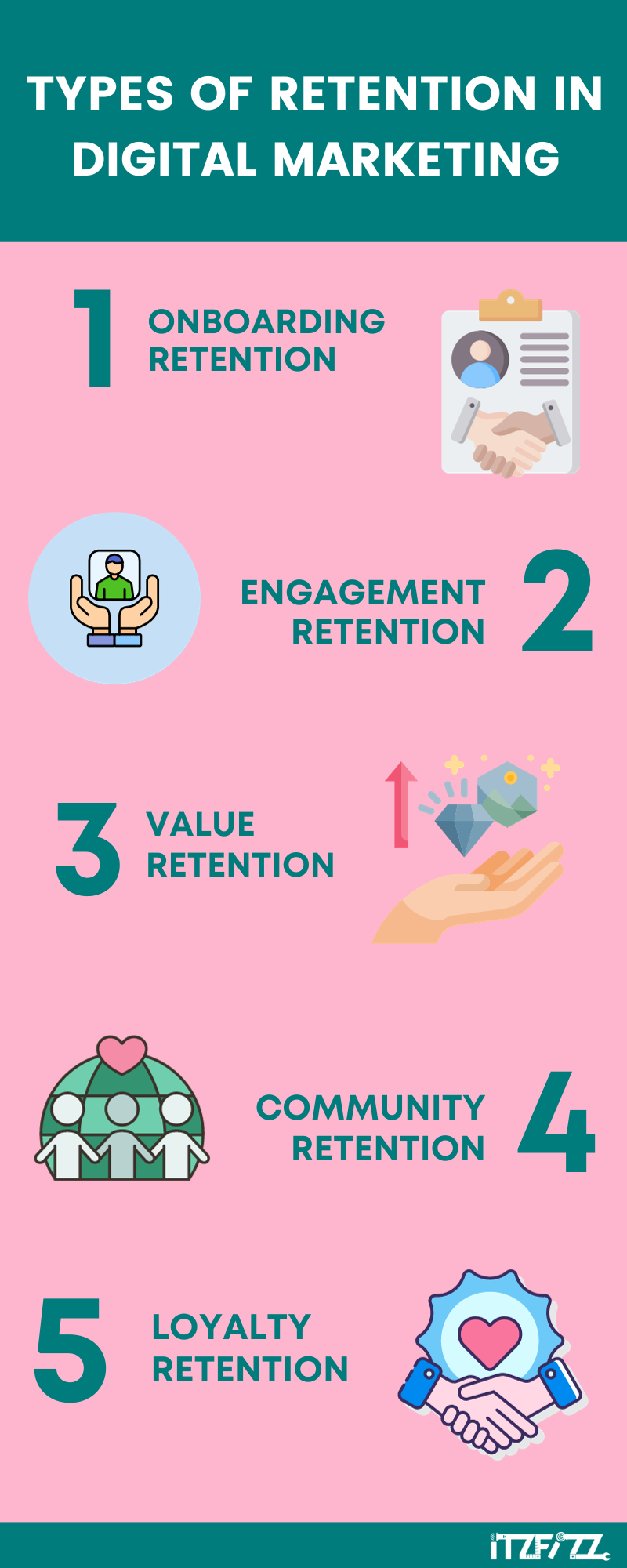Table of Contents
- Introduction to Retention in Digital Marketing
- Understanding customer behaviour
- Customer engagement strategies
- Personalised offers and recommendations
- Excellent Customer Service as a Retention Strategy
- Types of retention in digital marketing
- Strategies for retention in digital marketing
- Future trends in customer retention
- Conclusion
- Frequently Asked Questions

Introduction to Retention in Digital Marketing
In the bigger picture retention in digital marketing, is a very important concept. It all comes down to maintaining the customer satisfaction and brand loyalty of your present clientele. Retention focuses on maintaining your bonds with current clients rather than solely pursuing new ones.
In an extremely competitive sector where gaining new clients can be difficult and expensive, maintaining your current clientele becomes crucial. Retaining customers is a wise strategy rather than merely a statistic to monitor. Businesses that are skilled at retaining consumers not only thrive in the rapidly evolving digital landscape but also achieve remarkable success.
Understanding customer behaviour
You have to understand client behaviour if you want them to return. Data is like an ancient treasure in the digital world; it can tell you a lot about your customer preferences, purchasing habits, and social interactions. Digital businesses can truly understand their audience and make intelligent plans to retain clients by using sophisticated data tools.
In-depth data analysis involves more than just looking at numbers; it also involves identifying patterns in the behaviour of clients. You can precisely tailor your marketing to your customers’ interests by identifying the goods and services they adore. In addition to making consumers happier, this hands-on approach lays the groundwork for customised retention efforts.
Additionally, companies may improve their marketing, particularly online, by showcasing their satisfied clients, encouraging repeat business, preventing customer churn, cultivating enduring connections, and ensuring that their emails connect with their target audience. Together, these initiatives hope to convert one-time purchasers into lifelong clients and encourage existing clients to recommend the company to others.
Customer engagement strategies
Consumer interaction is comparable to a brand’s digital bridge to its target market. It’s more than simply business dealings; it’s about building genuine relationships and retaining customers. Social media, email, and interactive content are examples of powerful tools that organisations can use to maintain regular client communication.
Social media marketing is important for customer interaction in today’s environment. Brands can have instant conversations with their audience in this vibrant area. Social media is an effective way to maintain a vibrant and engaged consumer base, whether it be through the sharing of news, discounts, or prompt customer service.
Personalised Offers and Recommendations
The idea that one size fits all still applies to modern marketing but is no longer relevant in today’s environment. Nowadays, personalisation is in the spotlight as companies work to give their customers customised experiences. Personalised offers do more than just improve the buying experience; they create strong bonds between consumers and companies, encouraging engagement and loyalty.
The introduction of advanced technology, such as machine learning and algorithms, has completely changed how companies use data. By using these technologies, brands can evaluate enormous volumes of data and make very accurate predictions about consumer preferences.
Because of this technological powers, marketers can curate exclusive deals that speak to each customer individually and give them a sense of exclusivity and value. As a result, clients receive a customised approach that surpasses generic marketing tactics, making them feel genuinely special and appreciated by the brand.
Excellent Customer Service as a Retention Strategy
Providing excellent customer service is not only a good thing but a necessity in an environment where competition is strong. Customers are more inclined to continue with a brand even when other options seem alluring when they receive excellent customer service, defined as prompt and useful responses.
The individuals who provide direct customer service are quite essential. They are the ones influencing consumers’ perceptions of a brand. Making sure these teams can communicate effectively, handle issues quickly, and always have the client in mind is essential to training them to be outstanding support teams. Not only do well-trained teams resolve difficulties, but they also convert possible challenges into opportunities to increase customer satisfaction.
Types of Retention in Digital Marketing

As we continue our exploration of retention in digital marketing, it’s essential to understand the different types of retention strategies that businesses employ. These strategies are tailored to address various aspects of the customer lifecycle and contribute to building a sustainable customer base.
Here are the five main types of retention in digital marketing:
- Onboarding Retention: During the initial stages of their interaction with your product or service, this kind of retention aims to keep new users or customers interested. Numerous techniques, including tutorials, product demos, and welcome mailings, can be used to achieve this. You may improve the likelihood that users will stay around over time by creating a positive first impression and demonstrating the value of your product.
- Engagement Retention: The goal of this kind of retention is to keep current customers or users coming back for more. There are several ways to accomplish this, including delivering them customised information, giving them special discounts, and holding competitions and prizes. You may raise users’ lifetime value by providing them with a reason to return.
- Value Retention: Reminding users or customers of the value that your product or service offers is the main goal of value retention. There are several ways to accomplish this, including offering them positive online reviews from previous clients, emphasising new features or advantages, and conducting case studies. You can entice users to stay longer by demonstrating how your product or service is improving their lives.
- Community Retention: The goal of this kind of retention is to create a community around your good or service. Creating a forum or social media group for users to interact with one another, organising events, and holding competitions for user-generated material are just a few ways to accomplish this. Users are more inclined to stick with your brand if you give them a sense of belonging.
- Loyalty Retention: The goal of this kind of retention is to honour loyal customers or clients. There are several ways to accomplish this, including developing a loyalty programme, providing tiers of discounts, and providing exclusive previews or materials. You may entice users to return by demonstrating your appreciation for their business.
Understanding these different facets of retention allows businesses to develop a holistic approach, combining strategies that align with their goals and target audience.
Strategies for Retention in Digital Marketing
With a solid understanding of the importance of customer retention and the various types of retention strategies, let’s delve into actionable customer retention marketing strategies that businesses can implement to boost loyal customers in the digital world.
- Personalised email campaigns:
- We create emails that feel like they’re made just for you, considering what you like.
- Our data-driven insights help us suggest products or services tailored to your individual needs.
- Loyalty Programmes:
- Join our loyalty programme and get rewarded every time you make a repeat purchase.
- Enjoy exclusive content, discounts, or early access to keep you engaged with us.
- Social media engagement:
- We love chatting with you on social media commenting, messaging or enjoying our interactive content.
- Expect quick responses and vibrant online posts that make our social space lively.
- Continuous Data Analysis:
- We’re always analysing your data to spot evolving trends and preferences.
- Count on us to adapt and refine our strategies over time to keep things fresh.
- Feedback and surveys:
- Share your experiences through surveys; we genuinely want to hear from you.
- Your feedback helps us improve and proves our commitment to your satisfaction.
By incorporating these effective retention marketing strategies, businesses can create a comprehensive retention plan that retains existing customers and attracts new ones through positive word-of-mouth and brand advocacy.
Future trends in customer retention
As the business landscape evolves, customer retention strategies are adapting to meet changing consumer expectations. Future trends in customer retention include:
- Hyper-Personalisation: Using advanced statistics and artificial intelligence, experiences will be more intricately tailored to each individual’s tastes to provide hyper-personalised experiences, goods, services, and communications.
- Utilising predictive analytics to anticipate services: Predictive analytics will be essential in foreseeing client requirements and problems before they happen. Anticipatory service and proactive initiatives will increase client happiness and loyalty.
- Multichannel Experiences: It will be essential to have smooth transitions between different online and offline channels. Whether a customer interacts with a company in person, on social media, or through a mobile app, they anticipate a consistent experience.
- Emphasis on Emotional Connection: A key objective will be establishing emotional bonds with clients. Brands will make investments in emotionally charged experiences, community development, and storytelling to create enduring bonds.
- Subscription-Based Models: Subscription services, which provide ease and a dependable user experience, will keep becoming more and more popular. To keep customers around for a long time, brands will focus on adding value through subscription models.
- Proactive Customer Success: There will be a trend towards proactive customer success as opposed to reactive customer support. Offering clients tools, training, and assistance before problems arise shows that you care about their success.
- Environmental and Social Responsibility: Brands that exhibit social proof and environmental responsibility are gaining popularity among consumers. Companies that adopt sustainable techniques and give back to the community will notice an increase in their dedicated following.
- Community Engagement: Creating communities centred on brands is essential. Online or offline, consumer communities build peer-to-peer involvement and a sense of community, which increases customer loyalty.
- Virtual Reality (VR) and Augmented Reality Experiences: The use of AR and VR technologies will provide immersive brand experiences. These technologies will increase customer engagement through interactive product demos and virtual try-on sessions.
- Blockchain for Trust and Transparency: The application of blockchain technology will improve transactional trust and transparency. Processes that are clear and safe help build long-term connections with customers.
Adapting to these trends will be crucial for businesses aiming not only to acquire customers but also to build lasting relationships and foster brand advocates in an increasingly competitive market.
Conclusion
Retaining customers is essential to long-term success. Digital businesses can improve their relationships with customers in a variety of ways, such as by employing tailored strategies, leveraging data to analyse customer behaviour, or offering top-notch customer service.
By adopting a hybrid strategy that addresses engagement, loyalty, and transactions, business owners may effectively negotiate the intricacies of the digital realm. Strategies such as customised emails, loyalty plans, and social media engagement are effective in retaining customers as well as converting them into brand ambassadors.
Frequently Asked Questions (FAQ) :
Why is customer retention in digital marketing vital to your business?
Moreover, retained customers tend to make future purchases, boosting revenue. In the digital landscape, where competition is fierce, establishing a loyal customer base ensures long-term success, as customer retention is a testament to a brand's ability to deliver consistent value and customer experiences.
What is the best client retention strategy for your company?
However, understanding your unique customer base is crucial. Analysing data to identify preferences, implementing targeted marketing campaigns, and soliciting customer reviews can guide the selection of the most suitable retention strategies for your specific business context.
How do you retain customers on social media?
To promote a feeling of community, support user-generated material. By actively participating in online conversations, addressing customer concerns, and showcasing the human side of your brand, you can build lasting connections that contribute to customer retention on social media.










